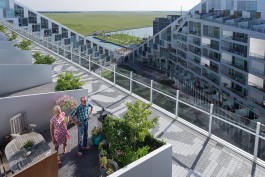



An interview with architect Kai-Uwe Bergmann, partner at BIG – Bjarke Ingels Group, about changing lifestyles in Copenhagen and about the office's visions on an international level.
Kai-Uwe Bergmann, how has urban life changed, especially in Denmark, where BIG has its roots? Do people today ask for other spaces than some decades ago? Do they spend their time differently, do they interconnect differently?
One of our first projects, the VM Houses, most certainly challenged the preconceived notions of what was acceptable in housing at the time it was built. Built to a relatively low budget the project has no interior dividing walls – using elements like the kitchen or pre-fabricated bathroom to separate rooms. Materials were used that one would not normally find in residential construction. Hallways and stairwells are open air – even in a Scandinavian climate. The VM Houses' 250 units were sold out within three weeks so there definitely was a demand in the market place that had never been addressed. Additionally projects like the 8 House demonstrate that you can build a nearly 500 unit residential building without a single parking space on site. People are interested in new ways of getting around – using sharing car services, using public transportation or even prioritizing the bicycle over other means. Our projects truly seek to consider new urban structures that reinforce how our generation wishes to live, work and play.



Copenhagen is considered one of the most liveable European cities when it comes to creating an urban vision for tomorrow. How far do experiences here help you to work in the international context, like in the U.S. where you are very busy?
Copenhagen has changed much over the past decade since BIG was founded. Perhaps the most striking transformation has been returning the waters edge from its industrial past to the people as cultural destinations or residential domains. This shift has brought a certain generosity back into the public realm which can be exemplified by our very first project, the Copenhagen Harbour Bath. This value then finds its North American expression through a project like the BIG U which redraws ten miles of Manhattan coastline from one that currently prioritizes transportation and industry into a publicly accessible social infrastructure that protects against sea level rise and provides the whole of Manhattan with a new urban amenity.
One connecting aspect of your projects seems to be that they are not just thought as buildings, but as spaces for urban interaction. Would you agree? How important is interdisciplinary cooperation for your work?
Architecture is a means to achieve a goal: to maximize the unfolding of human life. Since we design for very different tasks – libraries, hospitals, schools, museums, apartments, parking etc. – we need to engage with a whole army of people from other spheres and other professions than our own. For us, interdisciplinary collaboration is not a question of political correctness but rather a question of acquiring the right knowledge for the right question.



What does this mean, for example, for residential architecture? How flexible may it be to allow this unfolding?
Our residential projects do not rely on a single material or a specific detail, but rather create social and urban qualities regardless of the individual choices of the residents. They leave space for appropriation – the inhabitants can plant trees on their terraces, inhabit the structures without violating the architectural design, but rather enriching it. I think the impact people have on their city through the way they interpret it is as important or more than the limitations and possibilities we architects impose on it through the choices we make.

Profil
Kai-Uwe Bergmann is a Partner at BIG – Bjarke Ingels Group, a Copenhagen and New York based group of architects, designers, builders and thinkers operating within the fields of architecture, urbanism, research and development. Pursuing a “pragmatic utopian architecture that steers clear of the petrifying pragmatism of boring boxes and the naïve utopian ideas of digital formalism“, BIG has quickly become one of the most renowned architectural offices worldwide. Bergmann had various teaching assignments, participates on numerous international juries and lectures globally on the works of BIG.
www.big.dk
